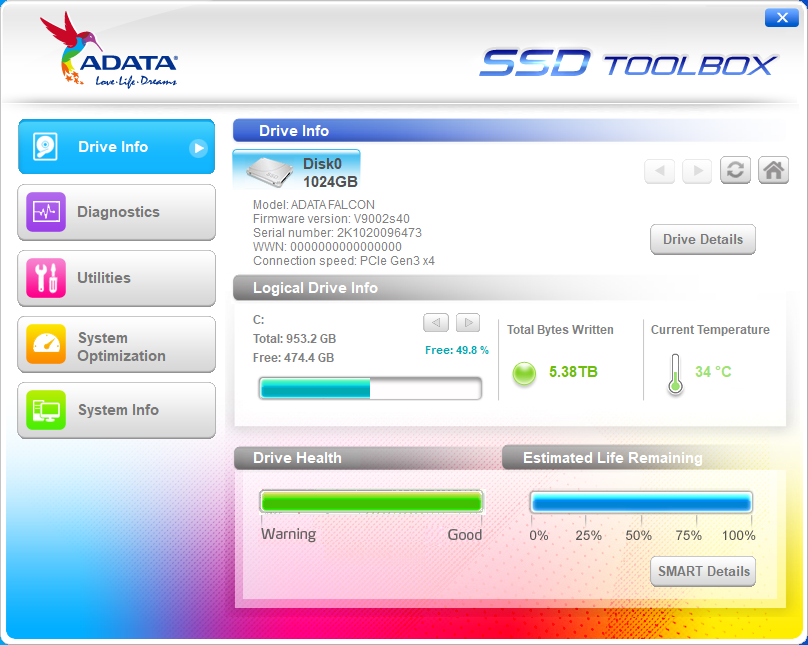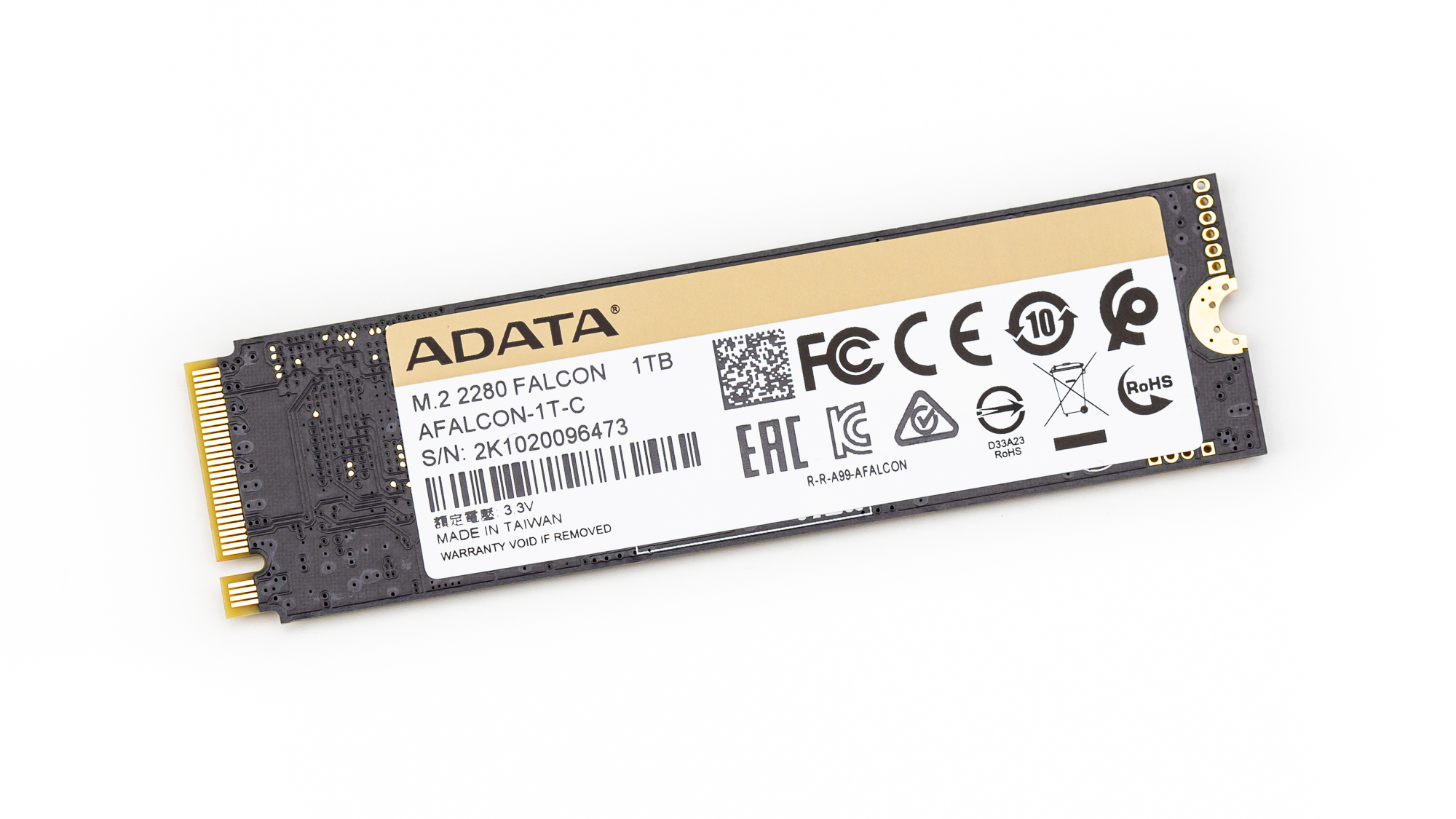Tom's Hardware Verdict
If you’re on the hunt for a flashy new NVMe SSD, be sure to consider the Falcon. Although it lacks DRAM, it delivers fairly consistent and predictable performance at a low price.
Pros
- +
Aesthetics
- +
5-year warranty
- +
Large dynamic write cache
- +
Single-sided PCB at all capacities
- +
SSD Toolbox and Migration Utility
Cons
- -
Slow write performance after the SLC cache fills
- -
Not as responsive as competing solutions
Why you can trust Tom's Hardware
Adata’s latest SSD, the Falcon, has flown into our lab in hopes of perching itself on our Best SSDs list. Adata’s Falcon sports multi-gigabyte per second performance and AES 256-bit encryption support for added security, but it also has stunningly good looks that are sure to complement the aesthetic of most builds. However, Adata’s Falcon isn’t the most responsive SSD available, largely because it lacks a DRAM buffer.
Adata’s Falcon is a compact M.2 NVMe SSD that the company claims is ideal for tasks like video editing, industrial drawing, and programming. Flaunting sequential performance figures of up to 3.1/1.5 GBps of sequential read/write throughput, as well as random performance of up to 180,000 read/write IOPS, it sure seems to fit the part performance-wise. But what really boosts potential prosumer adoption its hardware-based AES 256-bit encryption support. Adata’s Falcon can not only serve up data quickly, but it can also do so while keeping it secure.
Specifications
| Product | Falcon 256GB | Falcon 512GB | Falcon 1TB | Falcon 2TB |
|---|---|---|---|---|
| Pricing | $54.99 | $69.99 | $129.99 | $239.99 |
| Capacity (User / Raw) | 256GB / 256GB | 512GB / 512GB | 1024GB / 1024GB | 2048GB / 2048GB |
| Form Factor | M.2 2280 | M.2 2280 | M.2 2280 | M.2 2280 |
| Interface / Protocol | PCIe 3.0 x4 / NVMe 1.3 | PCIe 3.0 x4 / NVMe 1.3 | PCIe 3.0 x4 / NVMe 1.3 | PCIe 3.0 x4 / NVMe 1.3 |
| Controller | Realtek RTS5762DL | Realtek RTS5762DL | Realtek RTS5762DL | Realtek RTS5762DL |
| DRAM | DRAMless - HMB | DRAMless - HMB | DRAMless - HMB | DRAMless - HMB |
| Memory | Micron 96L TLC | Micron 96L TLC | Micron 96L TLC | Micron 96L TLC |
| Sequential Read | 3,000 MBps | 3,100 MBps | 3,100 MBps | 3,100 MBps |
| Sequential Write | 900 MBps | 1,500 MBps | 1,500 MBps | 1,500 MBps |
| Random Read | 100,000 IOPS | 100,000 IOPS | 180,000 IOPS | 180,000 IOPS |
| Random Write | 130,000 IOPS | 160,000 IOPS | 180,000 IOPS | 180,000 IOPS |
| Security | AES 256-bit encryption | AES 256-bit encryption | AES 256-bit encryption | AES 256-bit encryption |
| Endurance (TBW) | 150 TB | 300 TB | 600 TB | 1,200 TB |
| Part Number | AFALCON-256G-C | AFALCON-512G-C | AFALCON-1T-C 4 | AFALCON-2T-C |
| Warranty | 5-Years | 5-Years | 5-Years | 5-Years |
Adata’s Falcon is available in capacities that span from 256GB up to 2TB and is priced very competitively, especially the higher-capacity models that land as low as ~$0.12 per gigabyte for the 1TB and 2TB models. The Falcon uses Low-Density Parity-Check (LDPC) ECC and comes with endurance ratings that are competitive with many high-end SSDs, like the WD Black SN750 and Samsung 970 EVO Plus, but it still trails some SSDs that come with Phison SSD controllers. The 1TB Falcon is rated to endure up to 600 TB of writes within its 5-year warranty.
Software and Accessories
Adata provides both an SSD Toolbox and cloning software. The SSD Toolbox allows you to monitor, diagnose, and update the firmware of your SSD as well as ‘optimize’ some system configuration settings. Acronis True Image OEM enables you to clone your data to your new SSD and also create system images for backup purposes.


A Closer Look
The Falcon looks like a piece of jewelry more than an SSD. Normally, the heat spreader on an SSD is more rugged and industrial than flashy, but the Falcon’s gold-finished aluminum alloy heat spreader and black PCB pair up nicely for an absolutely stunning look.


Realtek’s RTS5762DL, an 8-channel DRAMless PCIe 3.0 x4 NVMe 1.3 SSD controller, powers the drive. The chip leverages dual ARM CPUs, and it’s package dimensions are much smaller than the RTS5762 we tested on Adata’s XPG Spectrix S40G. Its overall size is comparable to Phison’s newly-shrunk E12S 8-channel NVMe 1.3 SSD controller, a clue that suggests that it is manufactured on a 12nm process node, too.
This RTS5762DL allows for manufacturers to mount up to four NAND packages on the same side of the PCB as the controller, enabling the Flacon to maintain a slim single-sided M.2 2280 form factor even at the 2TB capacity point. Our 1TB sample interfaces with sixteen of Micron’s third-generation 96L (B27B) TLC 512Gb NAND dies at bus speeds of 533-667 MT/s. Adata sets aside 7% of the NAND for overprovisioning.
Get Tom's Hardware's best news and in-depth reviews, straight to your inbox.
While the RTS5762DL lacks DRAM for buffering flash translation layer (FTL) data, it uses NVMe’s Host Memory Buffer (HMB) feature so that the controller can use a few MB of the host system’s DRAM instead. While this presents a slight latency penalty due to the latency associated with communicating through the PCIe bus to the DRAM and back, overall performance is typically better than a DRAMless SSD without the tech. The drive also supports securing erasing via the Format NVM command, TRIM, and S.M.A.R.T. data reporting with a working temperature sensor.

Sean is a Contributing Editor at Tom’s Hardware US, covering storage hardware.
-
2Be_or_Not2Be This is an example of where technology is clearly changed/reduced only to save money for the mfg at the expense of the unknowing consumer. Removing DRAM only benefits the mfg, and it's bad for the consumer, especially when they don't know the technology limitations.Reply
So that being the case, it should be priced WELL below the pricing of competing solutions with DRAM (like Adata's own SX8200, as mentioned.) Pricing it only $10-20 less is a joke & a rip-off of the consumer, because no one is saying "I'd like to waste more time every single time I use my computer just to save $10".
P.S. Calling this drive a "prosumer" model is also a joke. -
InvalidError Reply
Well, a DRAM chip only costs ~$2, so the manufacturer isn't really saving all that much on the BoM from skipping it and still has to make its otherwise mostly unchanged costs, so it cannot make it all that much cheaper despite the substantially worse user experience.2Be_or_Not2Be said:Pricing it only $10-20 less is a joke & a rip-off of the consumer -
gg83 I have a 1tb adata s40 rgb m.2 and it seems fast. This seems to compete directly with it and the Falcon lacks dram. The dynamic cache must make the difference?Reply -
2Be_or_Not2Be ReplyInvalidError said:Well, a DRAM chip only costs ~$2, so the manufacturer isn't really saving all that much on the BoM from skipping it and still has to make its otherwise mostly unchanged costs, so it cannot make it all that much cheaper despite the substantially worse user experience.
Yeah, I'd prefer mfgs stop producing the cheaper tech & keep their profit margins with the existing higher-performing tech. Keep DRAM and drop QLC (also stop the "penta-layer" before that hits production). I've been through the changes from SLC to MLC and then TLC. TLC can mostly keep up the performance to MLC-levels, but QLC is definitely worse. So make the minimum level of flash tech at TLC, and then just work on improving your processes for better gains/profits. Then the consumer is getting the newer tech that actually improves performance, versus the "maybe" of QLC & DRAM-less SSDs.
Can't wait to switch to Optane/3D-XPoint Now that's where I'd love to see more research going into increasing capacity and lowering prices! -
2Be_or_Not2Be Replygg83 said:I have a 1tb adata s40 rgb m.2 and it seems fast. This seems to compete directly with it and the Falcon lacks dram. The dynamic cache must make the difference?
Your XPG Spectrix S40G is definitely better than the "Falcon". The onboard DRAM makes a difference in regards to performance. -
gg83 Reply
And it looks kickass!2Be_or_Not2Be said:Your XPG Spectrix S40G is definitely better than the "Falcon". The onboard DRAM makes a difference in regards to performance.

